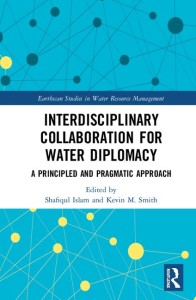An Argument for Problem-Driven Interdisciplinary Collaboration for Complex Water Issues
In our first post in this series, we argued that many of our current and emerging water problems arise from the inherent complexity of coupled natural and human systems. In our second post we discussed the importance of correctly identifying whether or not a system is complex when determining an appropriate response. In this post, we will look at an important consideration for practitioners who have determined that their system is complex: how can one best design and implement interdisciplinary collaboration for actionable outcomes for complex problems?
While interdisciplinarity is not without its critics and champions, by and large interdisciplinarity has come to be seen as an essential part of resolving many contemporary challenges in science and society. While we agree that interdisciplinarity is often necessary in responding to these challenges, we also regard it as rarely sufficient. In this sense, we emphasize Georges Gusdorf’s warning not to be lulled into the view of interdisciplinarity as an “epistemological panacea” (Gusdorf 1977, p. 580) as cited in Graff (2016). Rather, we suggest that interdisciplinarity needs to be regarded as a high-level strategy for innovation; its success or failure depends largely on the details of how it is pursued relative to the context in which it is applied. When it comes to interdisciplinarity, one size does not fit all.
More importantly, the widespread promotion of interdisciplinarity has not come with any unifying theory or instruction manual. Consequently, it is not clear how to operationalize interdisciplinarity in practice. In other words, there is little advice to guide practitioners in thinking critically about how their operating context may shape the way they collaborate to address complex problems. In Chapter 3 of our book, we explore the importance of context in orienting interdisciplinary collaboration to be effective. We begin our inquiry by asking: what mode of interdisciplinarity will help us to be effective in addressing problems in the space of (complex) coupled natural and human systems? What sort of requirements would it have?
In addressing these questions, we first note that many social and environmental problems often have immediate and compounding impacts that demand a rapid response. To this end, any collaboration must yield timely and actionable outcomes. Secondly, we need to recognize that complex systems are open and dynamic. For this reason, effective collaboration must acknowledge the non-finality and fallibility of its interventions by intentionally incorporating flexibility and capacity for contingent adaptive management. Finally, we must also recognize that the problems we seek to address often have dramatic effects on livelihoods that are not our own as academics or professional practitioners. In this sense, our chosen approach to collaboration must have explicit provision for inclusive stakeholder engagement and be sensitive to differences in culture and values.
These requirements, in our view, point to a strategy we call principled and pragmatic problem-driven collaboration. In our next blog post, we will more closely examine the importance of principles and pragmatism in carrying out this work; for the remainder of this post we will focus on the value of the “problem-driven” aspect of this strategy.
Problem-Driven vs. Theory-Driven
The current dominant mode of interdisciplinary collaboration is what we would call primarily theory-driven. It starts from the premise that the problem under study is systemic in nature. In turn, it is taken for granted that solving the problem requires a theory that can predict, or at the very least, explain the behavior of the system. On this view, the impetus for interdisciplinary collaboration is the recognition that “a full predictive or even descriptive understanding requires the use of many disciplines” (Institute of Medicine et al. 2005, p. 30). The hopeful outcome is that the theories from various disciplines can be synthesized into a theory-of-the-whole. Interdisciplinary collaboration of this sort has had a key role in the rapid growth of technological innovation in the last several decades. However, the vast majority of these successes were from the domain of physical and biological systems where prediction and control are possible because system behavior is governed by fundamental laws of nature. We would categorize most of these systems as simple or complicated, but not complex.
If the reliance on underlying laws of nature is a prerequisite for a theory-driven collaboration, one must question whether such a premise can serve us well in addressing our most pressing social, political, and economic challenges where natural and human systems are coupled. For millennia humans have viewed water – in addition to a physical object – as a cultural, religious, political, and economic object. As a result, many water issues are inherently complex and undermine reliable prediction and control. There are no generalizable laws that can govern water’s access, allocation, use, and transformations. Attribution of causality in such systems is fraught with practical and philosophical difficulties. We challenge the dominant premise that any amount of synthesis and tweaking of disparate notions of water – as physical, cultural, religious, political, or economic object – is likely to improve this condition.
Problem-driven collaborations, on the other hand, are undertaken without the objective of coming to any general solutions. Rather, the objective of our proposed problem-driven interdisciplinary collaboration is to bring a diversity of expertise to bear on a particular multi-faceted problem in order to achieve timely and actionable outcomes. Such an effort is undertaken without the expectation of ever weaving these disparate strands of knowledge into a cohesive or comprehensive whole.
Indeed, we argue that the best way to leverage diverse expertise in interdisciplinary collaborations is not to attempt to seek and build a unifying theory of the system, but to have interdisciplinary experts closely inspect the system and prudently identify the elements and interactions relevant to resolving a particular problem. We hasten to add that this approach need not be confused with advocacy for brash reductionism. Rather, the stance of the problem-driven interdisciplinary collaboration we promote is humble, principled, and pragmatic. Professionals ought to approach complex water systems with an unreserved reverence for the systems’ emergent qualities and explicit recognition of their own disciplinary blinders, yet, remain cognizant of the importance of timely and actionable outcomes.
The resultant findings and interventions, while informed and supported by the best available science and information, should not be expected to be exact or generalizable. Rather, problem-driven interdisciplinary work on complex water issues leads to a set of actionable options that are contingent, experimental, and subject to negotiation and informed consent of the affected parties. It achieves this by focusing not through the development of a shared theory, but a shared understanding of a specific problem. In achieving a shared understanding, we do not mean to suggest that all participants need to agree on all the attributes and features of a problem (i.e. agree on a theory), but rather, that they understand the ways in which their own perspectives and characterization of a problem may be in conflict with others.
Moreover, they need to be able to gauge whether and how these conflicts in perspective may matter to the resolution of the problem, or if they are practically inconsequential. Even if irreconcilable conflicts of perspectives exist, a problem-driven approach can still yield contingent pathways to resolution that embrace the uncertainty inherent in these differences in perception and characterization. In such situations, a portfolio of mutually agreed upon actionable interventions that represents the interests of all the parties can be a strong indicator of the feasibility of successful long-term collaborative management strategies.
In our next blog post we will outline the principled and pragmatic aspects of this form of collaboration and identify some concrete models that water professionals might adopt to help them think about their roles in collaborative efforts.
For the remainder of this series, which we are calling Interdisciplinary Collaboration For Water Diplomacy, we will continue to introduce and exemplify some foundational ideas spanning three thematic areas to translate theory to practice as illustrated in our recently released book. We will consider our effort worthwhile if it leads you to rethink as well as critique, refine, or replace the argument we are offering here. We look forward to sharing more highlights from the book in the coming weeks – and we invite you to engage with these ideas and send us your critical feedback. If you are interested in more details about the book, you can visit the publisher’s website. The book is also available on Amazon.



